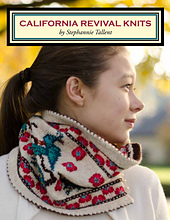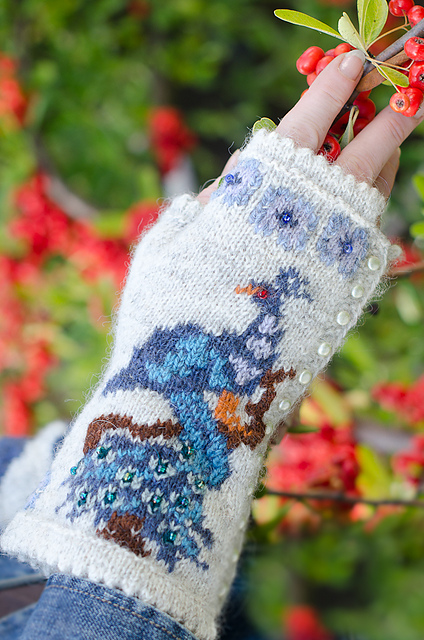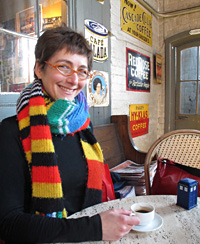I've heard from a few knitters that they're hesitant about knitting the
Doctor Who shawl because of the charts. It occurs to me that this might be a good time for a small chart reading tutorial.
Some pattern stitches are charted – lace and cables, most commonly. Charts are simply another way of representing a stitch pattern, nothing more. Any written instructions can be represented in a chart, any chart can be written out. As to which you prefer, it’s not about your talent or experience as a knitter, or your level of intelligence – it’s all about your learning style. Visual learners or those who are good at pattern recognition tend to prefer charts; auditory learners tend to prefer written instructions. One isn’t better or more proper than the other, they are just different.
Sometimes you’ll get both in a pattern, sometimes, only one. And often, the one that the pattern uses is a reflection of which one the designer herself prefers – nothing more! (It's also true that charts are easier to check than written instructions, and can take up less space.)
First things first, locate the legend. That’s the key – pun intended. Every chart will have a legend – whether on the same page, or at the end of the book or magazine. Always make sure you find it – not all symbols are standardized. Don’t worry, though, you’ll never have to guess.
Look at the numbers at the bottom – that tells you that this is worked over 7 stitches. And the numbers on the sides are the row numbers – there are 16 rows in total.
The row numbers are the clues to how the chart is read. Row 1, which is a RS row, is read from right to left. All RS rows are read from right to left. Row 2 (and all following even-numbered rows ) are WS rows, and they are read from left to right.
Think about a row of 7 stitches. You knit them in order: stitch 1, 2, 3, 4, 5, 6, 7. When you turn around to work back, you start with stitch 7, and work back to stitch 1. So charts are read in the direction you knit - from right to left on the RS rows and from left to right (stitches 7, 6, 5, 4, 3, 2, 1) on the WS rows.
Let’s take a look at the Legend. The last three symbols are easy, but there’s something funny going on with the first two. A blank square has two definitions: knit on the RS and purl on the WS.
Row 1 is a RS row, so it goes like this: P1, ssk, k3, yo, p1.
Row 2 is a WS row, so it goes like this: K1, p5, k1.
Why change the meaning? It’s because a chart
is a picture of the front (the right side) of your knitting. Really, a blank square means “do whatever you need to do so that the stitch shows as a knit on the RS”. And a knit on the RS is a purl on the WS. And the dot also has two definitions - purl on the RS and knit on the Ws - really just "do whatever you need to do so the stitch shows as a purl on the RS."
The other three symbols only have one definition since they are only worked on the RS.
This way, you can easily look at your knitting and compare it with the chart, and you’ll see they have a certain resemblance.
Some charts only show the RS rows – the row numbers will be the clue here: if a chart only has rows 1, 3, 5, ... and so forth. Look for some text near the chart -- or in the instructions where it first mentions the chart -- that describes what to do on the WS rows. This is sometimes done to make the charts smaller and easier to read – and you can assume that the WS rows are all going to be the same; in this case, it's most likely just a plain purl row. (In the case of Bigger on the Inside, there are some increased worked on the WS, so they need to be shown.)
For a project worked in the round, every row of the chart is read from right to left, because that's the direction in which you knit. And the symbols will never change meaning! After all, when you're working in the round, you're always on the RS, so that's how you read the chart - always on the RS.
No matter which you are more comfortable with, chances are you’re going to encounter a pattern that doesn’t have the one you like. If you find you prefer written instructions, feel free to write the rows out before you begin; if you prefer charts, you may want to draw charts for the written instructions. Use whichever you find easiest.
Now, for Bigger on the Inside, we've added something else - red boxes! These are repeat boxes.
On every 4th row (4, 8, 12, 16, 20, 24), a WS row, there's an increase. Which means that the number of sts increases. You can see this: the chart gets wider. The first time through the chart, work it exactly as written, ignore the red lines. After you're worked the 24 rows, you keep working them again and again (until you have 52 sts, specifically)... but you've got more stitches. 6 more, in fact. Enough to work the pattern in the red box once more. So the second time you work through the chart - rows 25-48, you start the chart as written, work the 6 stitches in the red box twice (until 2 sts are left in the row), and then finish with those 2 sts. And so forth.
And with the Decrease chart, you're taking away a repeat of the red box every 24 rows.
Excerpted and adapted from "Beyond Knit & Purl". If you liked this, find much more like it in my book!






























